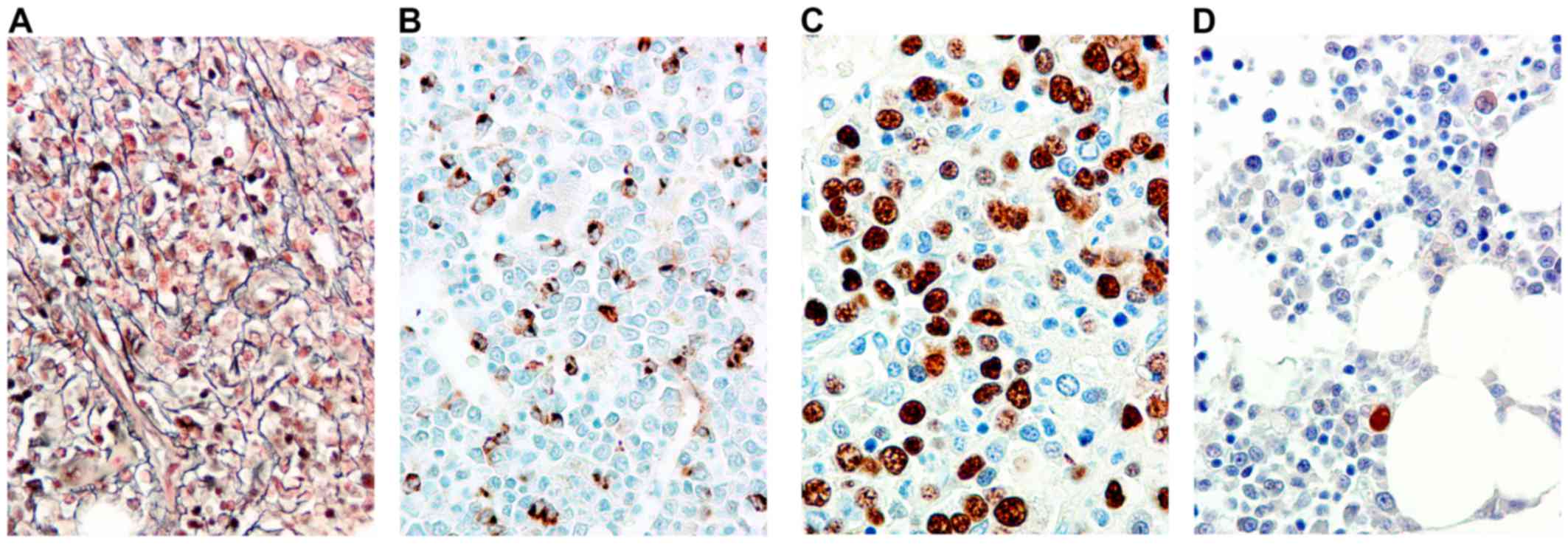|
1
|
Brunning RD, Orazi A, Germing U, Le Beau
MM, Porwit A, Bauman I, Vardiman JW and Hellstrom-Lindberg E:
Myelodysplastic syndromes/neoplasms, overviewWHO Classification of
Tumours of Haematopoietic and Lymphoid Tissues. Swerdlow SH, Campo
E, Harris NL, Jaffe ES, Pileri S, Stein H, Thiele J and Vardiman
JW: 4th. IARC Press; Lyon: pp. 88–93. 2008
|
|
2
|
Nagoshi H, Horiike S, Kuroda J and
Taniwaki M: Cytogenetic and molecular abnormalities in
myelodysplastic syndrome. Curr Mol Med. 11:678–685. 2011.
View Article : Google Scholar : PubMed/NCBI
|
|
3
|
Kaneko H, Misawa S, Horiike S, Nakai H and
Kashima K: TP53 mutations emerge at early phase of myelodysplastic
syndrome and are associated with complex chromosomal abnormalities.
Blood. 85:2189–2193. 1995.PubMed/NCBI
|
|
4
|
Christiansen DH, Andersen MK and
Pedersen-Bjergaard J: Mutations with loss of heterozygosity of p53
are common in therapy-related myelodysplasia and acute myeloid
leukemia after exposure to alkylating agents and significantly
associated with deletion or loss of 5q, a complex karyotype and a
poor prognosis. J Clin Oncol. 19:1405–1413. 2001. View Article : Google Scholar : PubMed/NCBI
|
|
5
|
Bejar R, Stevenson K, Abdel-Wahab O,
Galili N, Nilsson B, Garcia-Manero G, Kantarjian H, Raza A, Levine
RL, Neuberg D and Ebert BL: Clinical effect of point mutations in
myelodysplastic syndromes. N Engl J Med. 364:2496–2506. 2011.
View Article : Google Scholar : PubMed/NCBI
|
|
6
|
Kerns BM, Jordan PA, Moore MB, Humphrey
PA, Berchuck A, Kohler MF, Iglebart RC Jr, Bast JD and Marks JR:
p53 overexpression in formalin-fixed, paraffin-embedded tissue
detected by immunohistochemistry. J Histochem Cytochem.
40:1047–1051. 1992. View Article : Google Scholar : PubMed/NCBI
|
|
7
|
Iggo R, Gatter K, Bartek J, Lane D and
Harris AL: Increased expression of mutant forms of p53 oncogene in
primary lung cancer. Lancet. 335:675–679. 1990. View Article : Google Scholar : PubMed/NCBI
|
|
8
|
Chang H, Yeung J, Qi C and Xu W: Aberrant
nuclear p53 protein expression detected by immunohistochemistry is
associated with hemizygous P53 deletion and poor survival for
multiple myeloma. Br J Haematol. 138:324–329. 2007. View Article : Google Scholar : PubMed/NCBI
|
|
9
|
Chen MH, Qi CX, Saha MN and Chang H: p53
nuclear expression correlates with hemizygous TP53 deletion and
predicts an adverse outcome for patients with relapsed/refractory
multiple myeloma treated with lenalidomide. Am J Clin Pathol.
137:208–212. 2012. View Article : Google Scholar : PubMed/NCBI
|
|
10
|
Chang H, Jiang AM and Qi CX: Aberrant
nuclear p53 expression predicts hemizygous 17p (TP53) deletion in
chronic lymphocytic leukemia. Am J Clin Pathol. 133:70–74. 2010.
View Article : Google Scholar : PubMed/NCBI
|
|
11
|
Jädersten M, Saft L, Smith A,
Kulasekararaj A, Pomplun S, Göhring G, Hedlund A, Hast R,
Schlegelberger B, Porwit A, et al: TP53 mutations in low-risk
myelodysplastic syndromes with del(5q) predict disease progression.
J Clin Oncol. 29:1971–1979. 2011. View Article : Google Scholar : PubMed/NCBI
|
|
12
|
Kulasekararaj AG, Smith AE, Mian SA,
Mohamedali AM, Krishnamurthy P, Lea NC, Gäken J, Pennaneach C,
Ireland R, Czepulkowski B, et al: TP53 mutations in myelodysplastic
syndrome are strongly correlated with aberrations of chromosome 5,
and correlate with adverse prognosis. Br J Haematol. 160:660–672.
2013. View Article : Google Scholar : PubMed/NCBI
|
|
13
|
Müller-Thomas C, Rudelius M, Rondak IC,
Haferlach T, Schanz J, Huberle C, Schmidt B, Blaser R, Kremer M,
Peschel C, et al: Response to azacitidine is independent of p53
expression in higher-risk myelodysplastic syndromes and secondary
acute myeloid leukemia. Haematologica. 99:e179–e181. 2014.
View Article : Google Scholar : PubMed/NCBI
|
|
14
|
Orazi A, Cattoretti G, Heerema NA, Sozzi
G, John K and Neiman RS: Frequent p53 overexpression in therapy
related myelodysplastic syndromes and acute myeloid leukemias: An
immunohistochemical study of bone marrow biopsies. Mod Pathol.
6:521–525. 1993.PubMed/NCBI
|
|
15
|
Kitagawa M, Yoshida S, Kuwata T, Tanizawa
T and Kamiyama R: p53 expression in myeloid cells of
myelodysplastic syndromes. Association with evolution of overt
leukemia. Am J Pathol. 145:338–444. 1994.PubMed/NCBI
|
|
16
|
Brynes RK, Wilson CS, Kim AB and McCourty
A: Expression of p53, MDM2, p21waf1, bcl-2, and retinoblastoma gene
proteins in myelodysplastic syndrome after autologous bone marrow
transplantation for lymphoma. Mod Pathol. 10:1120–1127.
1997.PubMed/NCBI
|
|
17
|
Saft L, Karimi M, Ghaderi M, Matolcsy A,
Mufti GJ, Kulasekararaj A, Göhring G, Giagounidis A, Selleslag D,
Muus P, et al: p53 protein expression independently predicts
outcome in patients with lower-risk myelodysplastic syndromes with
del(5q). Haematologica. 99:1041–1049. 2014. View Article : Google Scholar : PubMed/NCBI
|
|
18
|
Porta MG Della, Malcovati L, Boveri E,
Travaglino E, Pietra D, Pascutto C, Passamonti F, Invernizzi R,
Castello A, Magrini U, et al: Clinical relevance of bone marrow
fibrosis and CD34-positive cell clusters in primary myelodysplastic
syndromes. J Clin Oncol. 27:754–762. 2009. View Article : Google Scholar : PubMed/NCBI
|
|
19
|
Cazzola M and Malcovati L: Prognostic
classification and risk assessment in myelodysplastic syndromes.
Hematol Oncol Clin North Am. 24:459–468. 2010. View Article : Google Scholar : PubMed/NCBI
|
|
20
|
Sugimoto K, Hirano N, Toyoshima H, Chiba
S, Mano H, Takaku F, Yazaki Y and Hirai H: Mutations of the p53
gene in myelodysplastic syndrome (MDS) and MDS-derived leukemia.
Blood. 81:3022–3026. 1993.PubMed/NCBI
|










